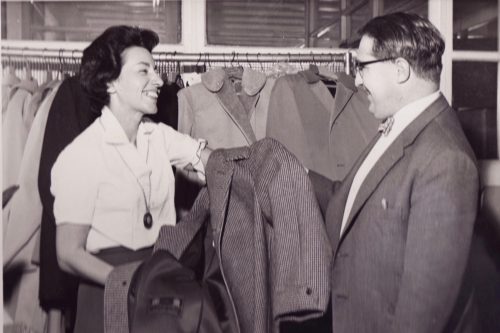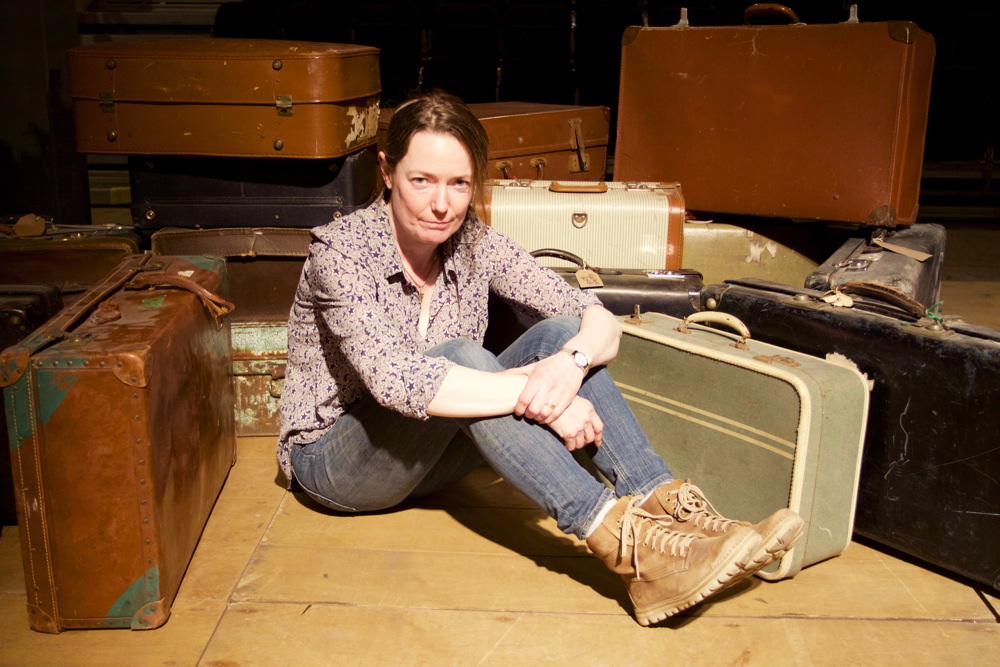Boxed in
To explain what it was like for a Jewish family hiding from Nazi troops a remarkable exhibition has opened in a Yorkshire mill. Roger Ratcliffe had a preview
“When we were in the box…” As a little girl Jenny Kagan remembers her parents going on and on about the time they lived in a big box.
In her mind she saw a box containing rosy-cheeked dolls. It wasn’t until she was in her twenties and visited Ann Frank’s famous hiding place at the rear of a canal house in Amsterdam that she began to fully understand what they’d meant. The dolls she had pictured so vividly in childhood were her mother, father and grandmother, and the box they’d so often spoken about had saved their lives.
It was a six-foot timber cube hidden behind a fake gable wall, which had been built across the dark attic of an iron foundry in the Lithuanian city of Kaunus. For nine months in 1943 and 1944, while 27,000 Jews were rounded up outside by Nazi invaders and sent to their deaths in concentration or extermination camps, the Kagans lived there with the support of a trusted friend.
It’s impossible for most people to imagine what that was like but the closest anyone will come to the experience today is an interactive show at Halifax, where the box has been recreated not in an attic but the gloomy bowels of the vast Dean Clough mill.
By the ingenious use of atmospheric lighting, music and imagery – including the spectral mirroring of visitors’ reflections on to life-sized photos of people who lived in Kaunus’s Jewish ghetto – the horror of the Holocaust is brought into sharp focus. And it probably couldn’t have been done by anyone other than Jenny, not just because it tells the story of her parents’ survival in the box but because she has spent much of her life as a lighting designer working on big West End and Broadway productions like Miss Saigon, Oliver and Les Misérables.
The Holocaust as an all-singing all-dancing show? Not quite, but the exhibition does have a deliberately theatrical look to it through the creative use of lighting and other stage techniques. Jenny says she didn’t want it to be too downbeat, since the story is essentially one of survival and optimism. “I realised it wouldn’t be a fun thing to go and see a show about the Holocaust, so I’ve been careful to make it engaging and enjoyable. I loved the fact that when I ran a preview, young people who came along said it was cool and funky.”
If her surname sounds familiar those with long memories will have heard of her father Joe Kagan, one of the three people who lived in the box. He is better known as the larger-than-life character who in the 1960s created one of the most famous mills in Yorkshire, at Elland, by inventing a textile called Gannex. Later he was Lord Kagan, a close friend of then Labour prime minster Harold Wilson who obtained the much sought-after Royal Warrant by clothing the Queen and Duke of Edinburgh in Gannex raincoats.
Joe Kagan, who lived in the box, later created one of Yorkshire’s most famous mills
Before the war, Joe’s father had owned a textile mill in Lithuania until invading Soviet troops nationalised it in 1940. When German forces rolled in a year later he was working at an iron foundry and became friends with a man named Vytautas.
In April 1943, it became obvious the Germans were intent on killing Kaunus’s Jews – now herded into a squalid ghetto – and Joe and Vytautas began to construct the box and the wall that would conceal it in the foundry’s attic.
On 28 October that year – Jenny is struck by the fact that she was born on the same day 22 years later – Jews started being sent to concentration camps and Joe, his new wife Margaret and mother Mira fled to the box, where Vytautus looked after them until Soviet troops re-invaded Lithuania the following summer and they managed to escape, eventually arriving on the doorstep of the British Consul in the Romanian capital of Bucharest.
There are two versions of the box in Jenny’s exhibition: the one her mother helped her design, which is a near-perfect relic of the original, and the one with dolls that she imagined as a child.
But the centrepiece is an extraordinary maze of barbed wire – the barbs are plastic – which visitors have to negotiate and make choices between moving left or moving right. It’s the same choice the inhabitants of the ghetto were presented with back in 1943, she says. Those who lined up on the left were sent to their deaths.

The exhibition climaxes with Jenny’s lighting skills full on. She describes it as a starscape, at which people gaze and initially see aeroplanes and insects but it is actually illuminated barbed wire. “It’s completely open to interpretation,” she says. “It’s outside the narrative. It is intended to generate an emotional response rather than an intellectual one. The reason I love this space at Dean Clough is that it’s dark and I can make it be whatever I want to. It becomes magical.”
Her show’s icon is the battered suitcase. She has been collecting them for years and dozens are scattered around as symbols of migration, the simple carriers of worldly possessions for the millions of Jews sent to their deaths. Some are in the shadows and some have labels inviting visitors to open them. Each tells part of the story. One reveals mechanised German tanks. Others have sounds and lights, even theatrical smoke and flames, all telling a different part of the story.
It ends with her parents’ escape to Romania. There is nothing about their arrival in Yorkshire where Joe started the Gannex business from scratch and became a multi-millionaire. When his fortunes were at their zenith the Kagans would be Wilson’s regular guests at Chequers. He ingratiated himself with the Royal Family, and among Jenny’s possessions is a sketch drawn by Prince Philip of a suggested picnic blanket made of Gannex.
His meteoric rise to wealth and status in Britain ended with a spectacular fall from grace in 1980 when he was convicted of stealing from his own companies and jailed for 10 months. The extraordinary tale of Joe’s Gannex years may feature in a future exhibition or book, Jenny says, but that part of his life doesn’t fit into the story of the box.
She acknowledges her father was well known but has deliberately avoided using his name. “I’m hoping people don’t see the show about my parents but at a level where it could actually be your story. The idea is that you experience the hiding places.”
She counts herself lucky that they, at least, spoke about their experiences. “A lot of survivors didn’t speak, but I grew up in this environment where my mum and dad talked about it all the time, to the point where I actually began to think: ‘Oh no, not another bloody story about the Holocaust.’ But now I really appreciate them.”
Out of Darkness (out-of-darkness.co.uk) is until 10 July at the Viaduct Theatre, Dean Clough, Halifax. Main photo: Jenny Kagan with some of the many suitcases in her exhibition (Roger Ratcliffe)

Leave a reply
Your email address will not be published.